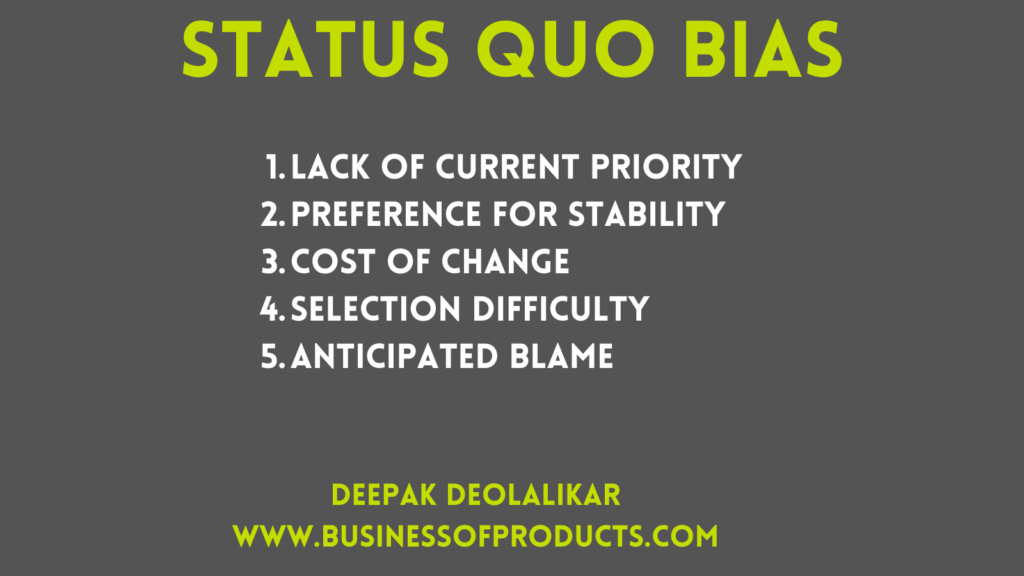What is status quo bias and how do PMs and founders overcome it

As founders and product managers, we sometimes do exhaustive competitive analysis. We do that to compare our product and find out how we can position to be different. The goal is to convince prospects that our solution is much better than all others.
But there is one big alternative we tend to overlook.
Status Quo, or sometimes called “Do nothing”.
It’s a form of bias the prospects have due to which they take no action.
Status quo bias is the tendency to prefer the familiar over the unfamiliar, even when a superior solution is available. You may argue that if you present them with a compelling product, why would customers not want to adopt your product. It does not make sense. But it happens. And there are psychological reasons behind it.
The status quo bias can afflict both founders or product managers building a new product or even a new feature.
B2B founders who are building new products will find it especially challenging to convince prospects, especially when the product is still young. There are some exceptions of course.
Product managers who are building new features or add on products will also find a similar challenge even with their existing customers. Just because your customers adopted your earlier product, does not mean they will do so with your next product. You have to apply the same level of rigor to explain value and get the product adoption, as you did with your earlier product.
So what do you do?
Understanding the core reasons behind this resistance—and countering them with strategic approaches—can help B2B PMs nudge customers from clinging to “good enough” solutions toward embracing innovative change.
There are five potential reasons for Status Quo bias exhibited by customers and prospects.
- Lack of current priority
- Preference for stability
- Cost of change
- Selection Difficulty
- Anticipated Blame

Let’s deep dive.
1. Lack of Current Priority
Problem: For many customers, implementing a new solution simply isn’t a priority amidst a host of competing demands. Even if they see the potential value, they may not consider it urgent enough to allocate time and resources right now. This lack of priority is common in B2B settings, where decision-makers are often focused on immediate operational needs or other high-priority projects. As a result, your product can easily fall by the wayside as something that they’ll “get to later” when things calm down. Even if later comes in a couple of months, there may be other competing priorities.
Think of your own personal situation. You have many goals and needs and wants in your life. Say you want to start a family, buy a house, go for an exotic vacation, or buy a new car etc. These are all competing demands of your precious resources – your wallet and your time. So you prioritize. You might say family is important so I will hold off on that vacation or hold off on buying a house. It’s not your current priority.
Now multiply that by a factor of 100 for B2B companies where they have millions of dollars riding on a decision. They have to be choosy.
Solution: To overcome this hurdle, make the need for your solution feel immediate and relevant to their current priorities. Identify and address the pressing pain points they’re currently facing and align your product’s benefits with their short-term goals. Demonstrate how your solution can contribute to immediate wins—like improving efficiency, increasing revenue, or enhancing customer satisfaction—that align with their present objectives. Offer a free pilot or time-sensitive promotion to create urgency and get your product on their radar as a priority.
Also, demonstrate the level of effort to be minimal for them. If they can get the benefit without too much of effort, they may consider.
This is a tough problem and you may not always be successful. Confirm that this is still a priority for them to solve at some time and find a suitable time in the near future to followup. If this is a luke warm priority, they will never get to it. If it is a Hell Yes priority, then they should get back to you when they are ready. Keep following up.
Example: Suppose a CRM company is targeting a prospect who relies on an outdated contact management system but doesn’t see CRM implementation as a priority due to a heavy workload. The CRM company can focus on how much time sales reps waste daily trying to access and update client information, which detracts from sales productivity. They could present a case study showing how another company achieved a 20% increase in sales efficiency within the first quarter by switching to the CRM. This can help the prospect see the immediate value and position CRM implementation as a quick win, aligning with their priority to maximize productivity without sacrificing more time on current manual processes.
2. Preference for Stability
Problem: Many customers stick with their current solution because it provides stability and predictability. The known is perceived as safer, even if it isn’t necessarily better. Customers often feel comfortable with a system that has already proven itself, one that they and their teams understand and use with minimal friction. However, while this stability might feel secure, it can prevent companies from addressing emerging challenges or capitalizing on new opportunities. For instance, if a customer’s current software solution is working “just fine,” they may overlook how new market demands or competitive dynamics are making it outdated.
Solution: To counter this bias, founders need to demonstrate how sticking with the status quo can actually introduce risk and create a false sense of security. Data and visuals showing market trends, competitor advancements, or regulatory changes that their current solution might not fully address can shift perceptions. Highlight specific risks, like operational inefficiencies or scalability limits, that may already be impacting them.
Example: Consider a B2B software company selling an advanced analytics tool that automates data visualization. Many prospects may currently use static spreadsheets or outdated reporting software. To destabilize their perception of stability, the company could show how manual processes in spreadsheets lead to human errors and missed insights, compared to automated updates with their solution. A case study of a similar business that reduced reporting errors and improved forecasting accuracy by switching to automated analytics could drive this point home, making the prospect feel that change is not just beneficial but necessary.
3. Cost of Change
Problem: Changing systems in a B2B environment often means a significant investment of time, training, and budget. Customers worry about implementation costs, onboarding time, and potential dips in productivity. This “cost of change” looms large, and even if a new solution promises benefits, the fear of short-term disruption can be enough to keep customers from making a move.
Solution: Founders can address this by presenting a compelling case for the long-term cost of maintaining the status quo. Sharing metrics, testimonials, and detailed ROI projections helps illustrate how sticking with the current solution may result in financial losses or productivity bottlenecks over time. By quantifying these hidden costs and highlighting the quick payback period of the new solution, founders can help reframe change as a strategic investment.
Example: A project management software company might encounter resistance from prospects using spreadsheets, due to fears around setup time and user training. To counter this, they could illustrate how much time teams currently waste on manual tracking and coordination. By providing data from a client who saw a 30% improvement in project delivery times within three months of switching, they can demonstrate the high cost of staying with an inefficient system. This shifts the conversation from “how much will it cost to change” to “how much is it costing not to.”
4. Selection Difficulty
Problem: With so many options on the market, customers can find it difficult to determine what makes one product better than another. If they can’t clearly differentiate between the benefits of a new solution and their current one, they may default to the familiar. This selection difficulty often results in customers feeling overwhelmed and hesitant to make a change, simply because they aren’t confident in the differences or the value proposition of the new offering.
Solution: To combat this, founders need to create a clear and compelling contrast between their product and the status quo. Truly understand what your customer is expecting and what is important to them. Visual aids like comparison charts, simplified benefit breakdowns, and case studies showing concrete advantages can make the decision easier. The goal is to reduce choice overload by emphasizing the unique value and specific benefits of the new solution, making the path to “better” feel straightforward.
Example: A cybersecurity software provider targeting customers who use basic antivirus software could highlight the advanced threat-detection capabilities that set their product apart. By providing a side-by-side comparison—such as detection speed, incident resolution time, and the depth of analytics—they can make the differences tangible. A testimonial from a client whose data breach was prevented by switching to the new software can further emphasize the impact, leaving little doubt as to the value of choosing their solution over the status quo.
5. Anticipated Blame
Problem: In B2B environments, decision-makers often worry that if the new solution fails or introduces issues, they’ll bear the blame. This anticipated blame can make them hesitant to make bold moves, especially if the current solution is “good enough.” The potential for failure—and the fear of responsibility for a wrong choice—can be a significant mental roadblock for adoption.
Solution: To alleviate this fear, founders should provide proof of value through endorsements, case studies, and data showing consistent success. By offering evidence of measurable results and testimonials from other respected companies in their industry, founders can instill confidence in their solution. Positioning the change as a reliable, low-risk choice backed by real-world success reduces the perception of potential blame. Offer to have the prospect talk to one of your customers.
Example: A cloud storage provider targeting organizations still using on-premise servers might encounter hesitation due to fears of potential data loss or transition issues. To address this, they could share success stories of similar companies that saved on infrastructure costs while improving data accessibility by moving to the cloud. They could also offer trial periods or data-backed case studies from recognized industry leaders, reassuring decision-makers that this transition is a proven step forward, not a leap of faith.
Conclusion
Status quo bias can be a tough challenge, but it’s one that can be overcome. By tackling each reason for resistance directly, founders can make a stronger case for change. The key is to understand and address customers’ real concerns, show how change can add value, and make it clear that moving forward is the smart choice for businesses that want to stay competitive.

